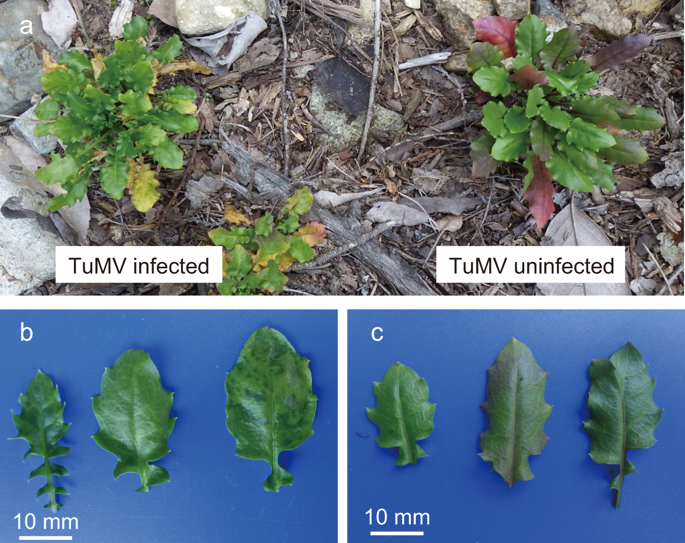Our official English website, www.x-mol.net, welcomes your feedback! (Note: you will need to create a separate account there.)
Seasonality of interactions between a plant virus and its host during persistent infection in a natural environment.
The ISME Journal ( IF 11.0 ) Pub Date : 2019-10-30 , DOI: 10.1038/s41396-019-0519-4 Mie N Honjo 1 , Naoko Emura 1, 2 , Tetsuhiro Kawagoe 1 , Jiro Sugisaka 1 , Mari Kamitani 1, 3 , Atsushi J Nagano 1, 3 , Hiroshi Kudoh 1
The ISME Journal ( IF 11.0 ) Pub Date : 2019-10-30 , DOI: 10.1038/s41396-019-0519-4 Mie N Honjo 1 , Naoko Emura 1, 2 , Tetsuhiro Kawagoe 1 , Jiro Sugisaka 1 , Mari Kamitani 1, 3 , Atsushi J Nagano 1, 3 , Hiroshi Kudoh 1
Affiliation

|
Persistent infection, wherein a pathogen is continually present in a host individual, is widespread in virus-host systems. However, little is known regarding how seasonal environments alter virus-host interaction during such metastability. We observed a lineage-to-lineage infection of the host plant Arabidopsis halleri with Turnip mosaic virus for 3 years without severe damage. Virus dynamics and virus-host interactions within hosts were highly season dependent. Virus accumulation in the newly formed leaves was temperature dependent and was suppressed during winter. Transcriptome analyses suggested that distinct defence mechanisms, i.e. salicylic acid (SA)-dependent resistance and RNA silencing, were predominant during spring and autumn, respectively. Transcriptomic difference between infected and uninfected plants other than defence genes appeared transiently only during autumn in upper leaves. However, the virus preserved in the lower leaves is transferred to the clonal offspring of the host plants during spring. In the linage-to-linage infection of the A. halleri-TuMV system, both host clonal reproduction and virus transmission into new clonal rosettes are secured during the winter-spring transition. How virus and host overwinter turned out to be critical for understanding a long-term virus-host interaction within hosts under temperate climates, and more generally, understanding seasonality provides new insight into ecology of plant viruses.
中文翻译:

在自然环境中持续感染期间植物病毒与其宿主之间相互作用的季节性。
持续感染,其中病原体持续存在于宿主个体中,在病毒宿主系统中广泛存在。然而,关于季节性环境如何在这种亚稳态过程中改变病毒与宿主的相互作用知之甚少。我们观察到宿主植物拟南芥用萝卜花叶病毒进行谱系间感染 3 年而没有严重损害。宿主内的病毒动力学和病毒-宿主相互作用高度依赖于季节。新形成的叶子中的病毒积累是温度依赖性的,并且在冬季被抑制。转录组分析表明,不同的防御机制,即水杨酸(SA) 依赖性抗性和RNA 沉默,分别在春季和秋季占主导地位。除防御基因外,受感染植物和未受感染植物之间的转录组差异仅在秋季上部叶片中短暂出现。然而,保存在下部叶片中的病毒在春季转移到宿主植物的克隆后代中。在 A. halleri-TuMV 系统的系间感染中,在冬春季过渡期间,宿主克隆繁殖和病毒传播到新的克隆莲座丛中都是安全的。事实证明,病毒和宿主如何越冬对于了解温带气候下宿主内的长期病毒-宿主相互作用至关重要,更一般地说,了解季节性为植物病毒生态学提供了新的见解。保存在下部叶片中的病毒在春季转移到宿主植物的无性系后代身上。在 A. halleri-TuMV 系统的系间感染中,在冬春季过渡期间,宿主克隆繁殖和病毒传播到新的克隆莲座丛中都是安全的。事实证明,病毒和宿主如何越冬对于了解温带气候下宿主内的长期病毒-宿主相互作用至关重要,更一般地说,了解季节性为植物病毒生态学提供了新的见解。保存在下部叶片中的病毒在春季转移到宿主植物的无性系后代身上。在 A. halleri-TuMV 系统的系间感染中,在冬春季过渡期间,宿主克隆繁殖和病毒传播到新的克隆莲座丛中都是安全的。事实证明,病毒和宿主如何越冬对于了解温带气候下宿主内的长期病毒-宿主相互作用至关重要,更一般地说,了解季节性为植物病毒生态学提供了新的见解。
更新日期:2020-01-17
中文翻译:

在自然环境中持续感染期间植物病毒与其宿主之间相互作用的季节性。
持续感染,其中病原体持续存在于宿主个体中,在病毒宿主系统中广泛存在。然而,关于季节性环境如何在这种亚稳态过程中改变病毒与宿主的相互作用知之甚少。我们观察到宿主植物拟南芥用萝卜花叶病毒进行谱系间感染 3 年而没有严重损害。宿主内的病毒动力学和病毒-宿主相互作用高度依赖于季节。新形成的叶子中的病毒积累是温度依赖性的,并且在冬季被抑制。转录组分析表明,不同的防御机制,即水杨酸(SA) 依赖性抗性和RNA 沉默,分别在春季和秋季占主导地位。除防御基因外,受感染植物和未受感染植物之间的转录组差异仅在秋季上部叶片中短暂出现。然而,保存在下部叶片中的病毒在春季转移到宿主植物的克隆后代中。在 A. halleri-TuMV 系统的系间感染中,在冬春季过渡期间,宿主克隆繁殖和病毒传播到新的克隆莲座丛中都是安全的。事实证明,病毒和宿主如何越冬对于了解温带气候下宿主内的长期病毒-宿主相互作用至关重要,更一般地说,了解季节性为植物病毒生态学提供了新的见解。保存在下部叶片中的病毒在春季转移到宿主植物的无性系后代身上。在 A. halleri-TuMV 系统的系间感染中,在冬春季过渡期间,宿主克隆繁殖和病毒传播到新的克隆莲座丛中都是安全的。事实证明,病毒和宿主如何越冬对于了解温带气候下宿主内的长期病毒-宿主相互作用至关重要,更一般地说,了解季节性为植物病毒生态学提供了新的见解。保存在下部叶片中的病毒在春季转移到宿主植物的无性系后代身上。在 A. halleri-TuMV 系统的系间感染中,在冬春季过渡期间,宿主克隆繁殖和病毒传播到新的克隆莲座丛中都是安全的。事实证明,病毒和宿主如何越冬对于了解温带气候下宿主内的长期病毒-宿主相互作用至关重要,更一般地说,了解季节性为植物病毒生态学提供了新的见解。



























 京公网安备 11010802027423号
京公网安备 11010802027423号